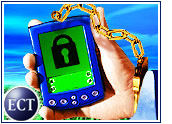
Two new technologies from the Palo Alto Research Center (PARC) — a Xerox subsidiary and spinoff company that has produced laser printing, Ethernet and the graphical user interface, among other innovations — promise to make wireless connections simpler and safer while giving today’s mobile devices a new way to communicate and learn from each other.
Researchers at the center, whose members recently won the National Academy of Engineering’s Charles Stark Draper Prize, said they have devised an automated and affordable method to make wireless networks highly secure using public and private key infrastructure (PKI).
In a second, parallel project, PARC researchers are touting the Obje platform as a software architecture that will enable simple, cross-standard interoperability among existing mobile, PC and electronic devices.
“These projects represent essential stepping stones — robust, usable security and simple interoperability — for operating in a world where computing is increasingly atomized, embedded and user-managed,” PARC president and director Mark Bernstein said.
Safer, Faster WiFi
Aiming to tackle the time and effort required to log on securely to WiFi networks — which have become popular but also have been hampered by security concerns amplified by user resistance to encryption and authentication schemes — PARC pointed to its secure wireless technology as a straightforward way for home and corporate users to achieve robust mobile security.
The technology involves the existing 802.1x protocol — which authenticates devices and users joining a wireless network — and eases initiation into the network, beginning with use of a location-limited, touch or infrared channel to exchange a cryptographic pair between device and network. The device, which is essentially lined up to the access point, then can use the existing wireless infrastructure to request a digital certificate, allowing automatic configuration of the device on the network.
The technology — intended to make security simple enough to be widely used — requires a two-step, two-minute process to set up 802.1x for a WiFi logon at its highest security level, compared with a more than 30-step, 90-minute process using traditional installation, PARC said.
Teaching Interoperability
Meanwhile, the Obje interoperability platform from PARC is an attempt to provide a software architecture that lets devices and services connect and interoperate over both wired and wireless networks.
PARC cited the convergence of computing, electronics and telecommunications as the driving force behind the project. That trend toward convergence also is leading Microsoft, Apple, Dell and HP deeper into the consumer-electronics market, while companies such as Panasonic seek to remain dominant in serving the home media center market, IDC vice president Roger Kay told TechNewsWorld.
PARC said that while traditional efforts have focused on achieving interoperability and protocol compatibility before products and services are released, Obje is based on the notion that existing devices and services can “teach each other how to work together without prior knowledge of each other or shared standards,” according to a brief on the new technologies.
All Devices, All Places
Proposed as “an industry and vendor-neutral way to drive interoperability,” Obje allows easy configuration, use and reuse of devices and services in an ad-hoc manner, according to PARC.
The center indicated the technology could be used for many purposes: to discover and aggregate music or other content from a variety of sources — PC, cable subscription and portable players; to ease development and rollout of mobile code, such as Java, for devices by eliminating compatibility issues among them; and to teach old hardware new tricks in the form of new formats.
Obje could perform all of these functions without requiring special wiring, software installation or configuration, PARC said.
“We have witnessed an explosion of digital devices in the home over the past few years,” said PARC principal of business development Hermann Calabria. “PARC envisions Obje as a means by which consumers will be able to network these devices and interact with information in a way that suits their needs rather than in a way that’s predicated on the limitations of individual devices.”
Silent Killer App
Calabria added that while existing standards-based approaches to interoperability among different devices and applications have proven successful, they take far too long.
“We feel [they] slow down the pace of innovation,” he told TechNewsWorld.
Calabria described the “killer app” of Obje as a room, car, hotel, store or other place where all of the devices in that space could interoperate without software drivers and regardless of device-level interoperability.
“The killer app is being able to do things you already do, but do them quickly and in ways you never thought possible,” he said, likening the technology’s impact to the mobility that cell phones delivered to voice communication.





















































